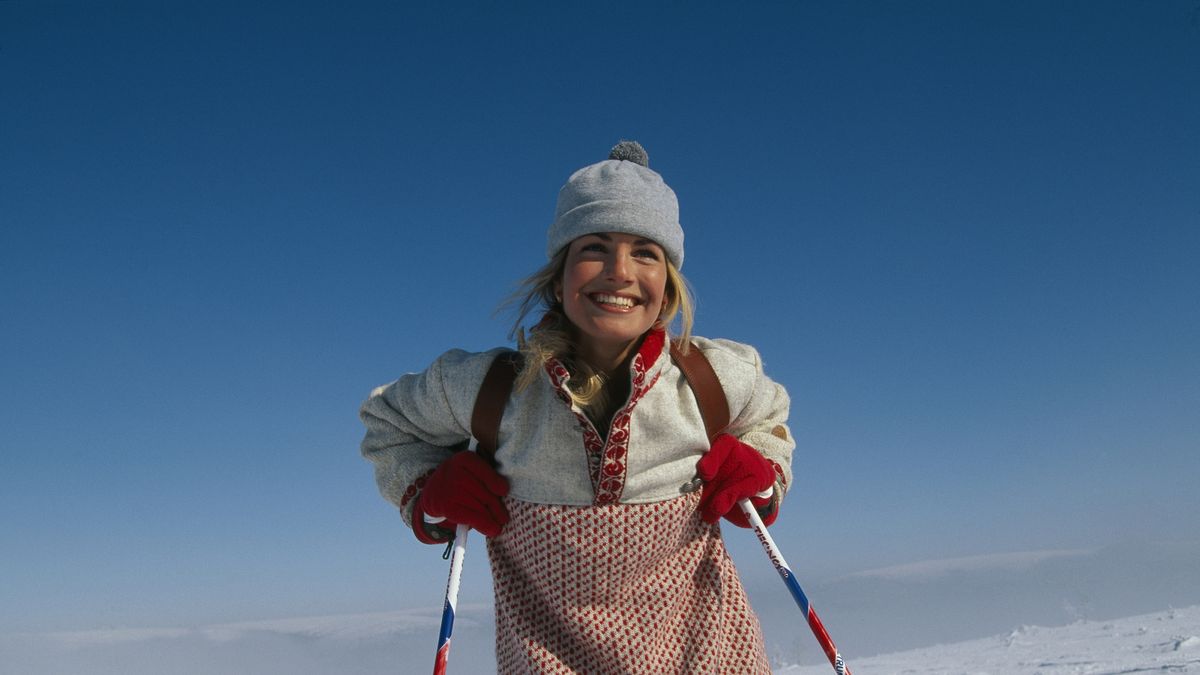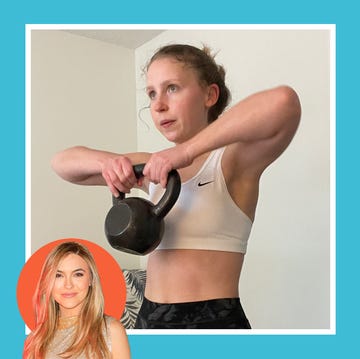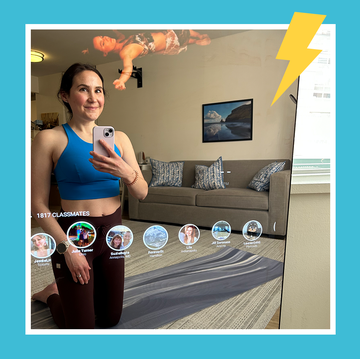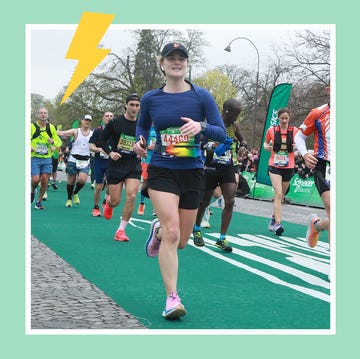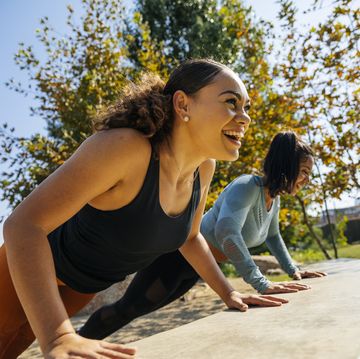'Tis the season for hitting the slopes. And whether you’re more excited for skiing or snowboarding (and sipping hot chocolate at the lodge, let's be real), you should definitely be thinking about getting your muscles conditioned for ski season. This way, you help avoid that first-day-back soreness.
ICYDK, training for a fun skiing or snowboarding season is all about strengthening your muscles and improving your cardiovascular endurance so that you can make it from first chair to last chair safely. “It’s important to condition yourself for skiing separate from other activities because skiing uses muscles in a different way than regular movement,” says Linda Scholl, DPT, ski fitness program coordinator at the University of Utah Orthopaedic Center.
Meet the expert: Linda Scholl, DBT, MPT, BCS, is the ski fitness program coordinator at the University of Utah Orthopaedic Center.
Skiing is an eccentric activity, which means you’re absorbing force rather than producing force as you move, Scholl says. (Take a mogul run, and you'll know exactly what I'm talking about.) The best way to train for this is to build up the key muscle groups dealing with that absorption—and for skiing, that's your quads, hamstrings, and your core. Building cardiovascular endurance is key, too, Scholl says. The good news for you? The following beginner-friendly program helps you work those exact muscles and more, so you never have to cut your ski day short again. (Psst, it's also an amazing workout for non-skiers!)
All in all, the strength you’ll build by paying attention to your legs, core, and cardio during this workout will help your endurance and efficiency so that you can tackle more runs and varying terrain without fatigue or injury, Scholl says. (Read: and have more fun!)
Get ready for your best ski and snowboard season yet with this ski workout from Scholl.
Best Ski Workout
Equipment: Bodyweight (dumbbells optional) Good for: Legs, core Time: 25 to 30 minutes
Instructions: Complete the prescribed reps and sets of each move, then continue to the next exercise on the list.
1. Bodyweight Squat
Why it rocks: Squats are one of the most important parts of a pre-season routine because "it's the position that your body will be in when you ski or snowboard," Scholl explains. (Just picture it.) It's basically prepping your frame to get in position and stay there as you make your way down the slopes.
How to:
- Start in a standing position with your feet hip-width apart.
- Slowly lower your butt down, hinging at your hips as if you're about to sit in a chair or hover above it. (Lead the movement with your butt and keep your back straight. Don't let your knees point inward.)
- Pause once you reach your lowest point.
- Engage glutes to stand up straight again. That's one rep.
- Complete three sets of 10 squats total.
Pro tip: For more challenge, you may hold a dumbbell, kettlebell, or plate.
2. Lateral Lunge With Balance
Why it rocks: You're constantly moving and ducking side to side when you're skiing or snowboarding, Scholl says, which is why it's important to practice lateral movements in your conditioning. These lateral lunges with balance can specifically protect your knees and hamstrings from injury, prepping your body for the awkward movements of ski that will also require balance and coordination, Scholl says.
How to:
- Start in a standing position with feet shoulder-width apart.
- With left leg planted on the ground, step the right out to the side.
- Bend the right leg at the knee and lower your butt in a squat-like position.
- Reverse the movement to return to standing, keeping right leg hovering.
- Grab your right knee with your hands and bring it to your chest.
- Lower right leg, immediately dropping back into the lunge position. That's one rep.
- Complete three sets of 10 reps on each leg. (If balancing is too difficult, you can modify the movement by doing just a lateral lunge, with no leg lift pause.)
3. Single-Leg Dead Lift
Why it rocks: Doing exercises combining balancing on one leg and strength "is a must" for ski conditioning, Scholl says. Why? "Putting yourself into variable positions and being able to stay solid on your leg can prepare you for the times you need to be on one ski," she explains, which is just a good safety measure as you prep for the slopes.
How to:
- Start standing with feet hips-width apart and hands at your sides.
- Slowly bend forward, hinging at the hips and lifting your right hand forward and swinging your right leg up and back as you move.
- Pause when your right hand and leg create a straight horizontal line.
- Reverse the movement to return to start. That's one rep.
- Complete three sets of 10 on each side. (For added difficulty, you may hold a dumbbell in your resting hand.)
4. Speed Skaters
Why it rocks: "Skiing is a lateral, weight shifting motion," Scholl says, which most of our daily activities and exercise fail to to mimic. That's what makes speed skaters ideal for conditioning—they help you balance and build lateral strength, especially in your knees. This will help prevent injury, Scholl says, and keep you safe on the slopes.
How to:
- Start in a standing position, ensuring that you have ample space on either side of you.
- With your left leg firmly planted, push off into a lateral jump, butt squatting backward, landing on your right. (Make sure you land softly and with your knees bent.)
- As you land, swing your left leg behind your right and touch your left hand to your right foot for added balance.
- Then, push off with your right leg and repeat movement toward your left side. That's one rep.
- Complete as many reps as possible (AMRAP) for 20 seconds. Repeat three times.
5. Plank
Why it rocks: "A strong core will make it easier for your whole body" when skiing, Scholl says. Classic planks are the perfect way to work your core while also engaging your butt, lower back, shoulders, and legs.
How to:
- Start on the floor on your hands and knees.
- Place your hands directly under your shoulders.
- Step your feet back, one at a time. (For more stability, bring your feet wider than hip-distance apart, and bring them closer for more of a challenge.)
- Maintain a straight line from the top of your head through your heels, gaze down just above your fingertips.
- Tighten your abs, quads, glutes, and hold. Think about digging through your heels, squeezing the quads, and keeping everything nice and tight. (If you feel your body shake, that's a good sign you're creating enough tension from head to toe.)
- Hold this position for 30 seconds or more. If you're struggling, go down onto your elbows or knees and hold there.
- Repeat three times.
6. Side Plank
Why it rocks: Side planks are excellent for the lateral core and hip control needed in skiing, Scholl says. Why? "Strength through the whole forward and side core will allow you to help get the edge you need to recover if off balance due to poor snow conditions or lighting," Scholl explains. Here's how to do them.
- Start lying on side with right forearm flat on the floor, elbow under shoulder, and both legs extended. Your body should form a straight line from head to feet, which are either stacked or staggered. (Your preference!)
- Engage your core and lift your hips up, ensuring that your body doesn't sag downward. Hold your free hand up in the air for a balance challenge.
- Hold the side plank for at least 30 seconds.
- Complete three holds, then switch sides and repeat.
7. Box Jump
Why it rocks: "Working on your ability to have good form when rebounding after landing from a jump will make those moguls safer and easy," Scholl explains. That's why she recommends incorporating box jumps into your routine, since you can practice landing and balance while also building strength in your legs and knees. (It'll likely get your heart-rate pumping, too!) Here's how to do them.
- Start by standing with feet hips-width apart facing a box or step, about two feet away from the base.
- Rise up onto balls of feet and swing straight arms over head, then bend knees and push hips back into a hinge position.
- Swing your arms behind your body to gain momentum and explode up off floor, jumping up onto the box.
- Land (softly!) in a half-squat position on the box with your knees bent, feet flat, and hands in front of your chest.
- Stand up straight and step back down to starting position. That's one rep.
- Complete AMRAP in 20 seconds. Complete three sets.
8. Glute Bridge
Why it rocks: This move works your hamstrings, which is the first line of defense in some knee injuries, Scholl explains. For this move, "squeezing your buttocks on the way up will help engage your glutes as well as your hamstrings. Double bonus!" Scholl says.
How to:
- Lie on your back with your feet flat against the floor and knees bent.
- Squeeze your glutes and lift your hips up off the floor until your body forms a straight line from your knees to your shoulders.
- Pause at the top.
- Lower back down to the starting position with control. That's one rep.
- Complete three sets of ten reps total.
Madeline Howard is a writer, editor, and creative based in Brooklyn. Her work has been published in Esquire, Nylon, Cosmopolitan, and other publications. Among other things, she was formerly an editor at Women’s Health. Subscribe to her newsletter ‘hey howie’ at madelinehoward.substack.com.
